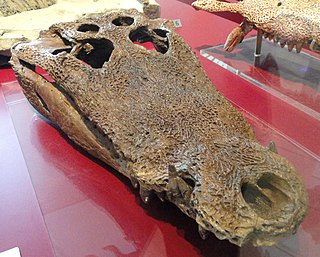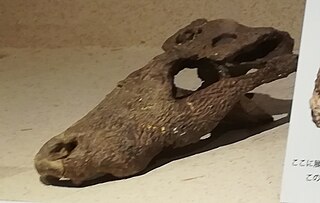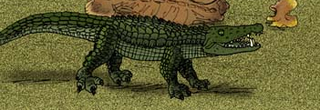
Ceratosuchus is an extinct genus of alligatorine crocodylian from latest Paleocene rocks of Colorado's Piceance Basin and earliest Eocene rocks of Wyoming's Bighorn Basin in North America, a slice of time known as the Clarkforkian North American Land Mammal Age. Like its modern relatives, Ceratosuchus was a swamp-dwelling predator. It is named for the pair of flattened, triangular bony plates that extend from the back of its head.

Boverisuchus is an extinct genus of planocraniid crocodyliforms known from the middle Eocene of Germany and western North America. It was a relatively small crocodyliform with an estimated total length of approximately 2.2–3.6 metres (7.2–11.8 ft).

Diplocynodon is an extinct genus of alligatoroid crocodilian that lived during the Paleocene to Middle Miocene in Europe. Some species may have reached lengths of 3 metres (9.8 ft), while others probably did not exceed 1 metre (3.3 ft). They are almost exclusively found in freshwater environments. The various species are thought to have been opportunistic aquatic predators.
Wannaganosuchus is an extinct genus of small alligatorid crocodylian. It was found in Late Paleocene-age rocks of Billings County, North Dakota, United States.
Procaimanoidea is an extinct genus of alligatorid from the Eocene of North America. It was named posthumously in 1946 by Charles W. Gilmore; the type species is P. utahensis, from the Uintan of Utah. It is based on USNM 15996, a nearly complete skull and partial left hind leg. A second species, P. kayi, was named in 1941 by C.C. Mook as a species of Hassiacosuchus, for remains from the Bridgerian of Wyoming. It was reassigned to Procaimanoidea in 1967 by Wassersug and Hecht.

Leidyosuchus is an extinct genus of alligatoroid from the Late Cretaceous of Alberta. It was named in 1907 by Lawrence Lambe, and the type species is L. canadensis. It is known from a number of specimens from the middle Campanian age Dinosaur Park Formation. It was a medium-sized alligatorid, with a maximum skull length greater than 40 centimeters (16 in).

Hassiacosuchus is an extinct genus of small alligatorid from the early Eocene of Germany, found at the Messel pit. It was named in 1935 by K. Weitzel, and the type species is H. haupti. A second species, H. kayi, was named in 1941 by C.C. Mook for material from the Bridgerian of Wyoming, but was reassigned to Procaimanoidea in 1967 by Wassersug and Hecht. Hassiacosuchus may be the same as Allognathosuchus; Christopher Brochu has recommended continuing to use Hassiacosuchus.

Alligatoroidea is one of three superfamilies of crocodylians, the other two being Crocodyloidea and Gavialoidea. Alligatoroidea evolved in the Late Cretaceous period, and consists of the alligators and caimans, as well as extinct members more closely related to the alligators than the two other groups.

Allognathosuchus is an extinct genus of alligatorine crocodylian with a complicated taxonomic history. It was named in 1921.

Navajosuchus is an extinct genus of alligatorine crocodylian. Its fossils have been found in the Paleocene-age Nacimiento Formation of the San Juan Basin, New Mexico. It was named in 1942 by Charles C. Mook, and the original type species was N. novomexicanus. N. novomexicanus was based on AMNH 5186, a partial skull collected in 1913. Later research showed that Navajosuchus novomexicanus was the same as the earlier-named Allognathosuchus mooki. However, A. mooki does not belong to the genus Allognathosuchus, and so the name of the crocodilian becomes Navajosuchus mooki. Under whichever name is used, this animal would have been a generalized predator of the Nacimiento floodplains. It was the most common Nacimiento Formation crocodilian, found in both the Puercan and Torrejonian faunal assemblages.

Brachychampsa is an extinct genus of alligatoroid, possibly a basal caiman. Specimens have been reported from New Mexico, Colorado, Wyoming, Montana, North and South Dakota, New Jersey, and Saskatchewan, though only those from Montana, Utah, and New Mexico are based on material sufficient to justify the referral. One specimen has been reported from the Darbasa Formation of Kazakhstan, although the species status is indeterminate for the fossil. The genus first appeared during the late Campanian stage of the Late Cretaceous and became extinct during the late Maastrichtian stage of the Cretaceous. Brachychampsa is distinguished by an enlarged fifth maxillary tooth in the upper jaw.

Planocrania is an extinct genus of eusuchian crocodyliforms from what is now China. Two species are currently known to belong to the genus.

Stangerochampsa is an extinct genus of globidontan alligatoroid, possibly an alligatorine or a stem-caiman, from the Late Cretaceous of Alberta. It is based on RTMP.86.61.1, a skull, partial lower jaws, and partial postcranial skeleton discovered in the late Campanian–early Maastrichtian-age Horseshoe Canyon Formation. Stangerochampsa was described in 1996 by Wu and colleagues. The type species is S. mccabei. The generic name honors the Stanger family, the owners of the ranch where the specimen was found, and the species name honors James Ross McCabe, who discovered, collected, and prepared it. Stangerochampsa is described as "small to medium–sized"; the type skull is 20.0 centimetres (7.9 in) long from the tip of the snout to the occipital condyle, and is 13.0 centimetres (5.1 in) wide at its greatest, while the thigh bone is 14.2 centimetres (5.6 in) long. It had heterodont dentition, with large crushing teeth at the rear of the jaws.
Krabisuchus is an extinct genus of alligatoroid crocodylian that existed in what is now Thailand during the Eocene. It was first named by paleontologists Jeremy A. Martin and Komsorn Lauprasert in 2010, and the type species is K. siamogallicus. Fossils have been found from the Krabi Basin of southern Thailand and include mostly cranial and mandibular elements as well as some postcranial remains. Krabisuchus is currently the most well known primitive alligatoroid from Asia; previously, these animals were only represented in Asia by a few fragmentary remains from China. The fossil record of alligatoroids is much more extensive in Europe and North America, where most taxa have been described.

Alligator prenasalis is an extinct species of alligator from the Late Eocene period. It is well known, with many fossils having been collected from the Chadron and Brule Formations in South Dakota. The species was first named in 1904, but was originally classified as a crocodile in the genus Crocodilus. It was reassigned to the genus Alligator in 1918 on the basis of more complete material. It is the earliest known member of the genus Alligator.

Globidonta is a clade of alligatoroids that includes alligators, caimans, and closely related extinct forms. It is defined as a stem-based clade including Alligator mississippiensis and all forms more closely related to it than to Diplocynodon. The group's fossil range extends back into the Late Cretaceous with early alligatoroids such as Albertochampsa and Brachychampsa. Extinct globidontans were particularly common in North America and Eurasia, and their modern range also includes South America.
Culebrasuchus is an extinct, monotypic genus of caiman alligatorid known from the Early to Middle Miocene (Hemingfordian) of the Panama Canal Zone of Panama. It contains a single species, Culebrasuchus mesoamericanus.

Planocraniidae is an extinct family of eusuchian crocodyliforms known from the Paleogene of Asia, Europe and North America. The family was coined by Li in 1976, and contains three genera, Boverisuchus, Duerosuchus and Planocrania. Planocraniids were highly specialized crocodyliforms that were adapted to living on land. They had extensive body armor, long legs, and blunt claws resembling hooves, and are sometimes informally called "hoofed crocodiles".

Orientalosuchina is an extinct clade of alligatoroid crocodylians from South and East Asia that lived during the Paleocene and Eocene.
Jiangxisuchus is an extinct genus of crocodylian that lived during the Late Cretaceous in what is now China. It was described in 2019, and was proposed to be a basal member of Crocodyloidea. However, another concurrent 2019 study recovered Jiangxisuchus instead as a basal member of Alligatoroidea, within the newly named clade Orientalosuchina.
















